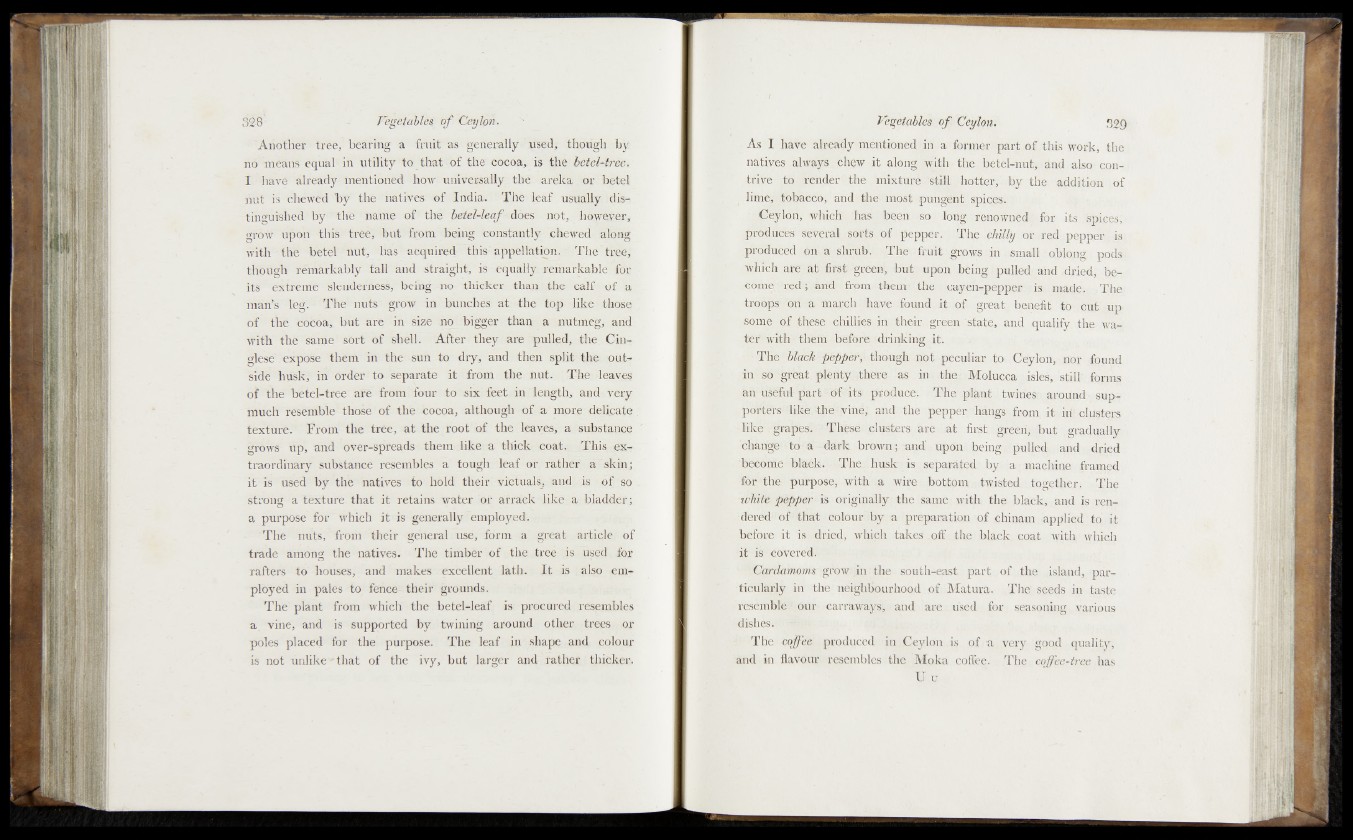
Another tree, bearing a fruit as generally jised, though by
no means equal in utility to that of the' cocoa, is the betel-tree.
I hav& -already- mentioned how universally the a re k a . or betel
hh t is chéwla b y the- natives: w>f Indian The'leaf usually distinguished*
by ' the name of the betel-leaf dóes - n o t,. however,
^ o # hfiott this tree, fbüt?%om #tóhg Constantly chewed?! along
with the b e te l'nut, has'acquired this-appellation.' The tfe®!
though retnarkably tall and straight, is equallyrremarkablel^for
it s iVéxiremé slenderness, being no thicker than the calf- of a
man’s leg. The nuts grow in bunches at the top -.like those
of the cocoa,, but are in size nojbigger than a nUtmeg,'and
with the same sort of shell. After they are pulled, th e Cin->
glese expose them in the sun to dry, and then split/ the out»
sidé'bdsk, in orderHö separate i t from the nut. ^The:?lea-^gs
of the betel-tree are from four to six feet in .'length, and'. Very
much resemble those of the cocoa, although of a more dcftcafe
texture. From the tree, a t the root of the leaves,-a substance
grows Up, and ovet-Spfeads them like- a th'ickï;>coat., This,.-ëx-r
traordïnary substance resembles a tough leaf or rather a skinj
it is' used by the natives -to hold théir^w&ïua^xiaddi ds*
strong 1 a texture, that it' retain® water ror arrack like.a;bladderj
a purpose for" which it is generally employed^.';:
'Thfe nuts, Tfödïf th e ir 'göierai:,Tise, fdfm aj- g reat ...ariaqk^lhf
trade among the natives» The timber o f. the tree f^s;onsed\ for
rafters fê‘ houses, and makes excellent lath. I t is ; lilspi ^gj^r
ployed in pales to fence- their grounds.
The plant from which th e . betel-leaf is procured res.embles
a. vine, and is supported by twining around other trees or
poles placed for the purpose. The leaf in shape and .cqlouf
is not unlike*1* that of the ivy, but larger and father thicker.
As I have already theiitioned^ili a .'former:;'.part of this work, the ,
natives always cfegw it along «with* the||jbetePnufe, and also-contrive
- to frender'Ube hhixtur&^still, hotter,, by tj f e addition of
Hhii^pobacco, aM^fe^inaoSt pungerib’.spiffCSrwJ. 1
* ' ifoB ijts-^ipes;
pr0di1cfeswWeral-!,s®MsK%fb pepper.,’ The pepper, is
produced pm a’ shrilb. The i fruit'grows in ^snaall oblong., pods*
which are a t firstilg^^feybbt’' upon being 1 pulktfoahd ,dried, be-
• and 'frpmrtbenp'thew cayen,pSpper-iSi made. , jThe<
feffjlpV/o'ri-a maijoh .'have -found itiidlif e reafbenefi h !tb-, cpt .up.
(Some of those? < In [lies i%|iheir g^ehl^fate!, ^apd^,qualify,Wile- wa~
ter^’wifh - tfefn-biibiiHildriidiing
1 TEe-flckk'ip&pper^ though nofe'iqieouliart.'zfo^‘byloii,^fer rfound
in' so-i%feat ^lefitygthefei as in .•.the; J$Sal4cca ' isles, -still forms
am h'sl!fu#^Vfea produce;.i i The'1.plantl twMesc.around • suppbMfedille
:thte'fpia^| and-.the' pepper' hangs ftom: clusters
.I l^ ^ r a ^ s § < r ^ ^ s e l%%ters, lJai-e - a t first J^geii&ibut *gr%dqall>y
change1*to-1 a -ddrk brown ; and' upop^being t^pulleokjiafidjwdried
betx)me-4blaAa-.yTihe^,husk-’ is separated1 by-.ai.'machine framed
for the purpose; with .a wire-bottom ,,twisted together; -,<The
whit® pepper is originally the .same; .with' fhg,-black, and is ;ren-
'dered^of^that Colour b y a preparation of ighinam applied to'-i,t
before it dried, which takes .oft. .the black, coat with1 which
-it -is1" covered^®1
■ ’ ‘Cardamoms grow in . the 1 south-east part of the fislapd, par-
rttidllrly in#the neighbourhood .ofnPfotura. The seeds in taste
resembte&’.Our- carrawaysi and are\used > for; s^sbpjeg', various-
dishes.1
b' The coffee- produced in . Ceylon is of 'a yefyrgqqd quality;
and in flavour resembles the Moka coffee. The coffee-tree has